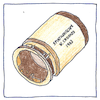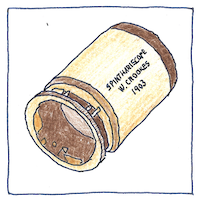Reginald Fessenden
electromagnetism

|
Spinthariscope
William Crookes spilled a little radium bromide on a screen coated with zinc sulfide. He noted under a microscope discrete scintillations— fluorescence from alpha particles emanating from the radium. Today the device he invented, the spinthariscope, is a novelty for viewing nuclear disintegrations. In its day it was wildly popular and led to the development of the Geiger counter and Rutherford’s model of the atom.
Scintillations
Today instead of radium bromide, which is dangerous, spinthariscopes use americium, but the scintillations are objectively the same. Then, they didn’t know how dangerous it was. They thought it was good for you, even fun, not only that it made the hands of your Timex visible in the dark, but also that it could cure eczema and psoriasis. If they had known, subjectively, there could have been more to it.
Fántasmascope
Suppose we could reconstruct a person’s past visual experiences by examining his retinas and brain. If so we could project these images on a tiny screen visible through a small lens. We could call them ghosts, and the Greek for ghost is fántasma. The only trouble is even though we know those images are in there, we cannot reconstruct them. If you start to see people who have passed away, you may be suffering from a form of dementia. This actually happened to someone I loved.



Many forms of particle detectors exist today, including the Geiger counter used to detect environmental radiation, and the Faraday cup used to detect results of particle accelerators.
See also in The book of science:
Readings in wikipedia:
Other readings: